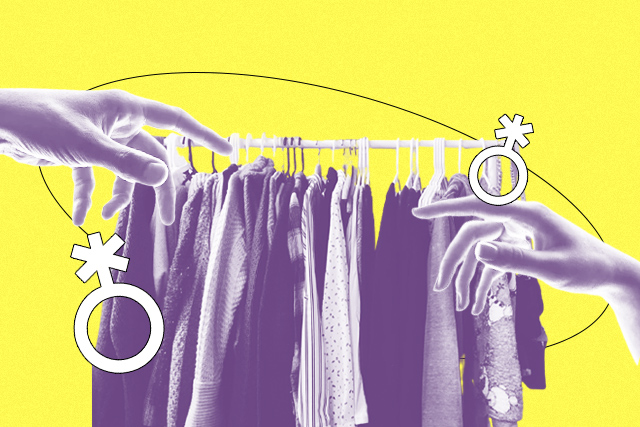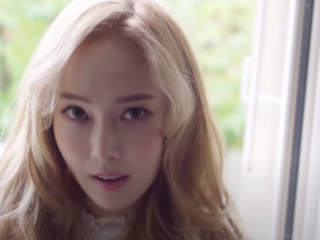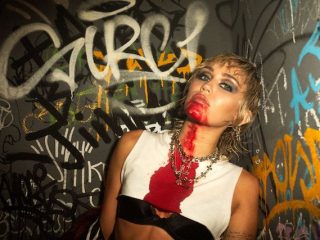
Fashion is fun but it can also be scary, especially when you feel pressured to present yourself in a way that would force the heteronormative society-at-large to validate your gender identity.
As a nonbinary person, dressing up (especially when meeting with family members!) can feel like an exam. Option A is what I really want to wear. Option B is what will make others think of me the way I want them to. Option C is the safest and would get me the least double-edged compliments.
I had a chat with one of my best friends, Katrina Nery, about what it’s like dressing up when you’re nonbinary and whether or not gender-neutral clothes is the key to making fashion more inclusive to nonbinary folk.
Amrie: Hey, Nery! Thanks for squeezing our little chat into your schedule. Before we dive into it, let’s share a few things about ourselves. I’ll start. I’m Amrie Cruz, a 23-year old nonbinary content creator. I remember meeting you at a pre-college event. My pre-college memories are a bit rusty but I’m fairly sure we clicked from the beginning. Correct me if I’m wrong, but I remember that we were asking each other about our SOGIE and we both said we were pansexual. We were 16-year-olds at that time, right?
Nery: Okay! I’m Nery, 23, and I’m a writing consultant. Yeah, I remember some bits of that day very clearly. We sat near each other, and I think we just got to talking about androgynous models like Erika Linder and Cara Delevigne because they were the hot topic at the time. Somehow, that led to a conversation about our SOGIE. Classic Tumblr discourse, really. And both of us had suuuper long hair back then, hah!
View this post on Instagram
Amrie: Ohmygod! Yes, Erika Linder. I haven’t heard that name for quite some time. Hot topic AND hot. Okay, now that our friendship origin story is out of the way, let me ask you this: When did you start identifying as nonbinary? Weird, I think I’ve never actually asked you this before.
Nery: It’s hard to talk about, I guess, for the both of us. I think we might have gone through this whole journey of self-discovery at the same time? Back in my fourth year of college, I enrolled in dance sport for PE class. The rules for it were simple: In every class, the girls wear heels and skirts while the boys wear slacks and dress shoes.
I respected the rules. I bought the strappy heels and everything, but I just couldn’t stomach it. I dragged my feet to every class even when I enjoyed dancing and liked the teacher. The worst part was that we had to dance in front of a mirror, so I had to watch myself next to this whole line of other girls, and then after we did our part, I would have to watch this whole other line of boys. I remember I just couldn’t stop thinking about how I didn’t “fit in” with either of them. I didn’t know which line I belonged to. Okay, that was kinda sad. What about you?
Amrie: Thanks so much for sharing this. Yeah, I think now I have a sort of complicated relationship with dancing. We have a mutual ex-friend who described the way I danced as sexy back in freshman year and I feel like if I heard that today I would just feel so sh*tty. In my case, I think it was around 2018 that I started feeling a level of gender dysphoria that had me reeling. I would get these anxiety attacks over the thought of people perceiving me as a girl.
I know you of all people wouldn’t really judge me for this but I’m a bit unwilling to admit that I think BTS played a huge part in helping me realize this about myself. More specifically, the ARMY fandom. At that time, I was making friends with fellow LGBTQIA+ ARMYs who were going through the same thing and, I guess, it got to the point where I couldn’t shrug it off anymore. It should be noted too that BTS inspires a lot of their fans to genuinely expressing themselves. I really think some of the members have read about Judith Butler’s notion of gender performativity.
View this post on Instagram
Nery: You’re right, I would never judge you for that, but I get what you mean. I think it’s because a lot of people chalk up these forms of self-expression and, by extension, self-identities as simply going by the trends. They’d go, “Weh, nakikiuso ka lang eh,” and maybe there’s a part of that that’s true, in a way. I mean, ‘di ko rin naman malalaman na pansexual ako kung hindi ko siya nakita sa Tumblr way, waaay back in the day, and di ko rin malalaman na nonbinary pala ako kung hindi nauso yung mga SOGIE infographics sa Facebook. So I’m not going to go around and judge people for finding out about themselves through BTS and ARMY. And I agree with you on that, especially with how the boys often wear clothes marketed for females (and enbys!) too.
Amrie: While it’s not necessarily true for everyone, people who learn more about their own gender and sexuality tend to experiment more with their gender expression. How do you describe your personal style and how is it different from how you used to dress up when you were younger? At the start of freshman year in college, my hair was nearly waist-length and my go-to outfit was a tight camisole with a sheer top. Now, I ask for a K-pop boy haircut when I go to the salon and my fashion philosophy is “the looser, the better.” On occasion though, I still appreciate tops that make my boobs look great but don’t try to destroy my ribcage.
Nery: Yeah, I remember when you first cut your hair short. It was so cute and stylish. As for me, I don’t think I had a consistent style back then primarily because I think that costs money—and I did not have that. [Laughs] But I used to wear a lot of skirts and uhh sportswear back then, and my hair was always just this plain, shoulder-length look. But I think the biggest theme of my “style” was just that they were very safe, and by safe, I meant that they passed very well for the standards of cis people. After graduating though, I started wearing my hair K-pop-boy-short too, and I’m not really comfortable with form-fitting clothes, so it’s always oversized, male fit polos and shirts for me. But I’ve developed a love for accessorizing. I love chokers, dangling sword earrings and hats!
View this post on Instagram
Amrie: I love getting updates when you touch up your hair! Like how many colors have you tried this year alone? You’ve done like platinum, blonde, orange, peach, purple…what else did I miss? Plus, you’ve been rocking that mullet—a win for the enbys! And one of the highlights of meeting up with our friend group, at least for me, is seeing all of our outfits and how similar our styles are. I freaking miss hanging out face to face.
Okay, I better get onto my next question before I start going full emo. How much of this style evolution is brought on by changes in how you identify as and how much of it is due to recent style trends?
Nery: I’ve never been one to keep up with style trends. I think the extent of my knowledge on style trends is just K-pop, which, obviously, is not always appropriate for society’s definition of casual wear, so it was more of just… kung anong nasa ukay na magustuhan ko, yun na, so siguro hindi na sila trendy given na ilang buwan (o taon?!) na yung lumipas bago siya napadpad sa closet ko. But I really had this very definitive moment where I was like, “I’m going to completely change my closet” because clothes started to become very difficult for me. There were days where I couldn’t go to class because I only had maybe four shirts that didn’t trigger my dysmorphia, so if I didn’t do laundry on time, which happened often, I wouldn’t be able to leave the apartment. Of course, it was a very slow revamping process because, you know, money, but I think I’ve got enough of an honest closet now. And I’m quite proud of my ukay finds too!
Are style trends something you keep up with and take inspiration from? I feel like the extent of our conversations on clothing is just that “Fish Fear Me, Women Want Me” hat that went around Twitter a couple of months ago.
Amrie: I take inspiration from trends on like a spiritual level, because of, like you said, money problems. Fashion is an interest that I don’t have the luxury to spend on. That’s partly the reason why sometimes when I buy clothes at ukays, I actively look for unusual pieces that would make me think, “Oh, it’s so funny that they made this” and “Not everyone could rock this but I probably could.” If I can’t afford to keep up with the trends, I’m not even going to pretend that I can. Since I’ve been thinking this way for a long-ish time, I feel like I’d end up going Harajuku-level eclectic with my wardrobe if I had the big budget. I’m not sure I’m cut out for chic and sophisticated at this point.
20-year-old Japanese fashion student Saki (@bamboo_blooms) on the street in Harajuku wearing a handmade cutout suit with a hand knitted muffler, hand knitted bag, face mask, vintage rings, Vivienne Westwood socks, and Dr. Martens boots #原宿 https://t.co/kvhJbCXGj2 pic.twitter.com/u8lUeTJjWH
— Tokyo Fashion (@TokyoFashion) November 14, 2020
Speaking of trends, a lot of brands are adopting a gender-neutrality label and there are designers who are also questioning the separation between womenswear and menswear. How progressive do you think this is?
Nery: I think it’s very comforting, really, but I think completely getting rid of the womenswear and menswear labels might not be the answer to, I don’t know, “living the enby life.” There are enbys who identify as nonbinary but still present themselves as specifically female or male, androgynous or they could even alternate through all of those on different days. Plus, I don’t want to take away these options from transgender people who abide and are validated by the binary, you know? I think, and not a lot of people might agree with me on this, progress is a lot more about leveling out the playing field than it is about erasing past mistakes. Like, maybe it wouldn’t be so bad to have all of these very specific, very gendered clothing catalogues all over my face if I knew I could flip over to the next page and find gender-neutral, explicitly stated and everything, clothes too.
What do you think, though? Would you be more comfortable shopping and dressing if we did away with the labels of gendered clothing?
Amrie: Personally, I think we would be better off if we traded gender-based labels with body shape labels and maybe style preference. That’s a possible solution to make fashion more inclusive in a lot of ways and a heck of a lot easier to find clothes that look good on you. Maybe it could even stop fast fashion. I can imagine how this system can make quality clothing more affordable and provide tailors more respect and just compensation.
If you google gender-neutral brands, most of the garments are in neutral shades or “gender-neutral” prints and are loose. As a nonbinary individual, what are your thoughts on gender-neutrality often being equated to androgyny?
Nery: It isn’t that I’m complaining about the whole “gender-neutral” shades or prints because I’m into simple, plain clothing too. It’s right up my alley. But it’s the same kind of mindset with the gender binary, isn’t it? The whole assigning gender to colors and prints? Except now it’s a third gender, nonbinary. Like, when did people even start deciding that beige was gender-neutral? Okay. Maybe I’m complaining a bit.
I can understand where the confusion comes from because people often think of androgyny as this perfect midpoint in the spectrum of femininity and masculinity, and there’s nothing wrong with people who like to take on this form of gender expression, but it’s limiting to a lot of enby folk, including myself. The association between these two terms has led to many thinking that there’s only one way of being nonbinary, and that’s in presenting as androgynous, as being a carefully curated fashion style of 50% feminine and 50% masculine. While some nonbinary folk do want to find that perfect balance, it becomes a bit damning for those who don’t fit into that. I can’t really tell you what it is that makes someone Nonbinary™, because that’s up for themselves to decide, but I can say that androgyny is not the be-all and end-all for all of us, and I think that’s something a lot of people still need to understand.
Amrie: Exactly. One of my fears is how gender neutrality is becoming like a marketing term and industry buzzword. If nonbinary is being seen as the third gender, then creating so-called “gender-neutral” clothing might just morph into another way to sell more clothes instead of trying to break stigmas. For me, clothes shouldn’t be gendered but I understand that it would take decades for that to happen and that a lot of people find comfort in being able to present as feminine or masculine through clothes. Heck, I’m not above it. But it’s two-way, right? If I didn’t feel like I have to look a certain way to be perceived by others how I want them to, I wouldn’t feel as self-conscious about my fashion choices. If fashion is a visual art, how come the word androgynous doesn’t really come up when we describe films or paintings? The terms feminine and masculine are still being used to describe art but I don’t think we need it. We can critique form and content without these labels. To me, a future that isn’t binary is possible.
Nery: I agree with you, wholeheartedly, and it’s a future that I look forward to every day!
Art by Jan Cardasto
Follow Preen on Facebook, Instagram, Twitter, YouTube and Viber
Related Stories:
Lesley Mobo and Renz Reyes: Is Fashion Week going out of fashion?
We ask a designer couple—what’s genderless fashion?
I ran out of fashion inspo so I dug up ’80s magazines
I’m so over your ‘figure-flattering’ fashion tips

